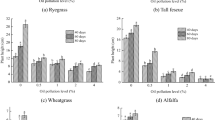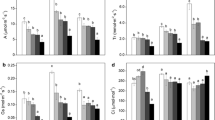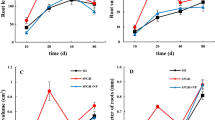Abstract
Background and aims
Sea-buckthorn (Hippophae rhamnoides) is widely domesticated and cultivated in orchards worldwide. With the advantages of a large root system and the symbiosis of fibrous roots with Frankia, a group of N2 fixing bacteria which form nodules with the roots, sea-buckthorn can grow in harsh environment under extreme weather conditions. However, its tolerance to petroleum contamination in the soil has so far not been studied. To elucidate whether sea-buckthorn can be employed for phytoremediation of petroleum contamination, its remediation efficiency as well as its growth and metabolic traits in petroleum contaminated soil were examined in an experiment with potted plants.
Methods
Sea-buckthorn seedlings were planted in soils with four different petroleum concentrations from April to September in a pot experiment. The responses of growth, gas exchange and the antioxidative system were examined on three sampling dates. After 5.5-month of exposure, soil petroleum remediation was evaluated in planted and unplanted soils.
Results
The petroleum decontamination rate was significantly enhanced by H. rhamnoides in soils with petroleum contamination up to 15 g kg−1 after one growing season. The root to shoot ratio increased continuously with the increase of the petroleum concentration as a consequence of reduced biomass allocated to the shoots, probably as a mechanism to counteract stress by the petroleum contamination of the soil. Photosynthesis was enhanced by lower petroleum concentrations in the soil (≦15 g kg−1) in September. Short-term exposure (in July) to high petroleum concentrations (20 g kg−1) in the soil enhanced ascorbate peroxidase (APX), glutathione reductase (GR), superoxide dismutase (SOD), and catalase (CAT) activity and increased ascorbic acid (AsA) and glutathione (GSH) contents, indicating elevated activity of the Foyer-Haliwell-Asada-Cycle. However, similar effects were not observed at long-term exposure.
Conclusions
Our results prove that sea-buckthorn is a promising tool for phytoremediation of petroleum contaminated soils up to 15 g kg−1 in loess plateau soil in China.







Similar content being viewed by others
References
Abdullah SRS, Al-Baldawi IA, Almansoory AF, Purwanti IF, Al-Sbani NH, Sharuddin SSN (2020) Plant-assisted remediation of hydrocarbons in water and soil: application, mechanisms, challenges and opportunities. Chemosphere 247:125932. https://doi.org/10.1016/j.chemosphere.2020.125932
Ahmad A, Khan WU, Shah AA, Yasin NA, Ali A, Rizwan M, Ali S (2021) Dopamine alleviates hydrocarbon stress in Brassica oleracea through modulation of physio-biochemical attributes and antioxidant defense systems. Chemosphere 270:128633. https://doi.org/10.1016/j.chemosphere.2020.128633
Ali MH, Sattar MT, Khan MI, Naveed M, Rafique M, Alamri S, Siddiqui MH (2020) Enhanced growth of mungbean and remediation of petroleum hydrocarbons by Enterobacter sp. MN17 and biochar addition in diesel contaminated soil. Appl Sci 10:8548. https://doi.org/10.3390/app10238548
Andrade ML, Covelo EF, Vega FA, Marcet P (2004) Effect of the prestige oil spill on salt marsh soils on the coast of Galicia (northwestern Spain). J Environ Qual 33:2103–2110. https://doi.org/10.2134/jeq2004.2103
Arab L, Hoshika Y, Müller H, Cotrozzi L, Nali C, Tonelli M, Ache P, Paoletti E, Alfarraj S, Albasher G, Hedrich R, Rennenberg H (2022) Chronic ozone exposure preferentially modifies root rather than foliar metabolism of date palm (Phoenix dactylifera) saplings. Sci Total Environ 806:150563. https://doi.org/10.1016/j.scitotenv.2021.150563
Asghar HN, Rafique HM, Khan MY, Zahir ZA (2017) Phytoremediation of light crude oil by maize (Zea mays L.) bioaugmented with plant growth promoting bacteria. Soil Sediment Contam 26:749–763. https://doi.org/10.1080/15320383.2017.1414771
Asiabadi FI, Mirbagheri SA, Najafi P, Moatar F (2014) Phytoremediation of petroleum-contaminated soils around Isfahan oil refinery (Iran) by sorghum and barley. Curr World Environ 9:65–72. https://doi.org/10.12944/CWE.9.1.10
Barrs HD (1968) Determination of water deficits in plant tissue. In: Kozlowski TT (ed) Water deficits and plant growth. Academic Press, New York, pp 235–368
Baruah P, Deka S, Baruah PP (2016) Phytoremediation of crude oil-contaminated soil employing Crotalaria pallida Aiton. Environ Sci Pollut Res 23:10595–10603. https://doi.org/10.1007/s11356-016-6227-y
Beyer WF, Fridovich I (1987) Assaying for superoxide dismutase activity: some large consequences of minor changes in conditions. Anal Biochem 161:559–566. https://doi.org/10.1016/0003-2697(87)90489-1
Bradford MM (1976) A rapid and sensitive method for the quantitation of microgram quantities of protein utilizing the principle of protein-dye binding. Anal Biochem 72:248–254. https://doi.org/10.1006/abio.1976.9999
Bramley-Alves J, Wasley J, King CK, Powell S, Robinson SA (2014) Phytoremediation of hydrocarbon contaminants in subantarctic soils: an effective management option. J Environ Manag 142:60–69. https://doi.org/10.1016/j.jenvman.2014.04.019
Ciesarova Z, Murkovic M, Cejpek K, Kreps F, Tobolkova B, Koplik R, Belajova E, Kukurova K, Dasko L, Panovska Z, Revenco D, Burcova Z (2020) Why is sea buckthorn (Hippophae rhamnoides L.) so exceptional? A review. Food Res Int 133:109170. https://doi.org/10.1016/j.foodres.2020.109170
Cui BX, Han G, Li KR, Wang B (2014) Response of growth and antioxidant protection system of Caragana Korshinskii to oil-contaminated soil. Pratacultural Sci 31:632–640. (in Chinese)
Cui BX, Zhang XX, Han G, Li KR (2016) Antioxidant defense response and growth reaction of Amorpha fruticosa seedlings in petroleum-contaminated soil. Water Air Soil Pollut 227:121. https://doi.org/10.1007/s11270-016-2821-3
Ding H, Zhu W, Yang S, Yang X (2005) Dynamic changes in antioxidative systems in roots of tomato (Lycopersicom esculentum Mill.) seeding under zinc stress and recovery. Chin J Appl Environ Biol 11:531–535
Ellman GL (1959) Tissue sulfhydryl groups. Arch Biochem Biophys 82:70–77. https://doi.org/10.1016/0003-9861(59)90090-6
Foyer CH, Noctor G (2011) Ascorbate and glutathione: the heart of the redox hub. Plant Physiol 155:2–18. https://doi.org/10.1104/pp.110.167569
Gao S, Liang J, Teng T, Zhang M (2019) Petroleum contamination evaluation and bacterial community distribution in a historic oilfield located in loess plateau in China. Appl Soil Ecol 136:30–42. https://doi.org/10.1016/j.apsoil.2018.12.012
Gong JR, Zhao AF, Zhang LX, Zhang XS (2004) A comparative study on anti-oxidative ability of several desert plants under drought stress. Acta Bot Boreal-Occident Sin 24:1570–1577. (in Chinese)
Haider FU, Ejaz M, Cheema SA, Khan MI, Zhao B, Cai L, Salim MA, Naveed M, Khan N, Nunez-Delgado A, Mustafa A (2021) Phytotoxicity of petroleum hydrocarbons: sources, impacts and remediation strategies. Environ Res 197:111031. https://doi.org/10.1016/j.envres.2021.111031
Han G, Cui BX, Zhang XX, Li KR (2016) The effects of petroleum-contaminated soil on photosynthesis of Amorpha fruticosa seedlings. Int J Environ Sci Technol 13:2383–2392. https://doi.org/10.1007/s13762-016-1071-7
He WL, Huang CH, Yang YL, Zhang F, Zhang LX (2004) Protective of ascorbic acid against salt stress. Acta Bot Boreal-Occident Sin 24:2196–2201. (in Chinese)
Hoang SA, Sarkar B, Seshadri B, Lamb D, Bolan NS (2021) Mitigation of petroleum-hydrocarbon-contaminated hazardous soils using organic amendments: a review. J Hazard Mater 416:125702. https://doi.org/10.1016/j.jhazmat.2021.125702
Kampfenkel K, Van Montagu M, Inzé D (1995) Extraction and determination of ascorbate and dehydroascorbate from plant tissue. Anal Biochem 225:165–167. https://doi.org/10.1006/abio.1995.1127
Landi M, Cotrozzi L, Pellegrini E, Remorini D, Tonelli M, Trivellini A, Nali C, Guidi L, Massai R, Vernieri P, Lorenzini G (2019) When “thirsty” means “less able to activate the signalling wave triggered by a pulse of ozone”: case of study in two Mediterranean deciduous oak species with different drought sensitivity. Sci Total Environ 657:379–390. https://doi.org/10.1016/j.scitotenv.2018.12.012
Li XY (2006) A study on the relationship of character and morphologic anatomy structure and ecological adaptability on sea-buckthorn. Doctor thesis in Inner Mongolia Agricultural University, Huhhot, China. (in Chinese)
Lichtenthaler HK (1987) Chlorophylls and carotenoids: pigments of photosynthetic biomembranes. Meth Enzymol 148:350–382. https://doi.org/10.1515/znc-2001-11-1225
Liu W, Hou J, Wang Q, Ding L, Luo Y (2014) Isolation and characterization of plant growth-promoting rhizobacteria and their effects on phytoremediation of petroleum-contaminated saline-alkali soil. Chemosphere 117:303–308. https://doi.org/10.1016/j.chemosphere.2014.07.026
Ma X, Li X, Liu J, Cheng Y, Zhai F, Sun Z, Han L (2020) Enhancing Salix viminalis L.–mediated phytoremediation of polycyclic aromatic hydrocarbon–contaminated soil by inoculation with Crucibulum laeve (white-rot fungus). Environ Sci Pollut Res Int 27:41326–41341. https://doi.org/10.1007/s11356-020-10125-3
Merkl N, Schultze-Kraft R, Infante C (2005) Phytoremediation in the tropics--influence of heavy crude oil on root morphological characteristics of graminoids. Environ Pollut 138:86–91. https://doi.org/10.1016/j.envpol.2005.02.023
Mukherjee SP, Choudhuri MA (1983) Implication of water stress-induced changes in the levels of endogenous ascorbic acid and hydrogen peroxide in vigna seedings. Physiol Plant 58:166–170. https://doi.org/10.1111/J.1399-3054.1983.TB04162.X
Nadim F, Hoag GE, Liu S, Carley RJ, Zack P (2000) Detection and remediation of soil and aquifer systems contaminated with petroleum products: an overview. J Pet Sci Technol 26:169–178. https://doi.org/10.1016/S0920-4105(00)00031-0
Naidoo G, Naidoo Y, Achar P (2010) Responses of the mangroves Avicennia marina and Bruguiera gymnorrhiza to oil contamination. Flora 205:357–362. https://doi.org/10.1016/j.flora.2009.12.033
Newman LA, Reynolds CM (2004) Phytodegradation of organic compounds. Curr Opin Biotechnol 15:225–230. https://doi.org/10.1016/j.copbio.2004.04.006
Odjegba VJ, Sadiq AO (2002) Effects of spent engine oil on the growth parameters, chlorophyll and protein levels of Amaranthus hybridus L. Environmentalist 22:23–28. https://doi.org/10.1023/A:1014515924037
Odukoya J, Lambert R, Sakrabani R (2019) Impact of crude oil on yield and phytochemical composition of selected green leafy vegetables. Int J Veg Sci 25:554–570. https://doi.org/10.1080/19315260.2018.1563845
Park IS, Park J-W (2011) Determination of a risk management primer at petroleum-contaminated sites: developing new human health risk assessment strategy. J Hazard Mater 185:1374–1380. https://doi.org/10.1016/j.jhazmat.2010.10.058
Peng S, Zhou Q, Cai Z, Zhang Z (2009) Phytoremediation of petroleum contaminated soils by Mirabilis Jalapa L. in a greenhouse plot experiment. J Hazard Mater 168:1490–1496. https://doi.org/10.1016/j.jhazmat.2009.03.036
Pilipovic A, Orlovic S, Nikolic N, Borisev M, Krstic B, Roncevic S (2012) Growth and plant physiological parameters as markers for selection of poplar clones for crude oil phytoremediation. Sumarski List 5–6:273–281
Rane NR, Tapase S, Kanojia A, Watharkar A, Salama E-S, Jang M, Yadav KK, Amin MA, Cabral-Pinto MMS, Jadhav JP, Jeon B-H (2022) Molecular insights into plant-microbe interactions for sustainable remediation of contaminated environment. Bioresour Technol 344:126246. https://doi.org/10.1016/j.biortech.2021.126246
Redondo-Gomez S, Petenello MC, Feldman SR (2014) Growth, nutrient status, and photosynthetic response to diesel-contaminated soil of a cordgrass, Spartina argentinensis. Mar Pollut Bull 79:34–38. https://doi.org/10.1016/j.marpolbul.2014.01.009
Ruan CJ, Li DQ (2002) Community characteristics of Hippophae rhamnoides forest and water and nutrient condition of the woodland in Loess Hilly Region. Ying Yong Sheng Tai Xue Bao 13:1061–1064
Saruyama H, Tanida M (1995) Effect of chilling on activated oxygen-scavenging enzymes in low temperature-sensitive and-tolerant cultivars of rice (Oryza sativa L.). Plant Sci 109:105–113. https://doi.org/10.1016/0168-9452(95)04156-O
Schaedle M, Bassham JA (1977) Chloroplast glutathione reductase. Plant Physiol 59:1011–1012. https://doi.org/10.1104/pp.59.5.1011
Sexton TM, Steber CM, Cousins AB (2021) Leaf temperature impacts canopy water use efficiency independent of changes in leaf level water use efficiency. J Plant Physiol 258-259:153357. https://doi.org/10.1016/j.jplph.2020.153357
Shukry WM, Al-Hawas GHS, Al-Moaikal RMS, El-Bendary MA (2013) Effect of petroleum crude oil on mineral nutrient elements, soil properties and bacterial biomass of the rhizosphere of jojoba. Br J Environ Clim Change 3:103–118. https://doi.org/10.1556/abot.55.2013.1-2.8
Somtrakoon K, Chouychai W (2013) Phytotoxicity of single and combined polycyclic aromatic hydrocarbons toward economic crops. Russ J Plant Physiol 60:139–148. https://doi.org/10.1134/S1021443712060155
Sui B, Dang X, Fan L, Guo B, Bi W, Liu G (2022) Interactions between soil conservation and dryland farming of heterogeneously eroding areas in Loess Hills, China. Int Soil Water Conserv Res 10:574–585. https://doi.org/10.1016/j.iswcr.2022.01.003
Tanida M (1996) Catalase activity of rice seed embryo and its relation to germination rate at a low temperature. Breed Sci 46:23–27. https://doi.org/10.1270/jsbbs1951.46.23
Wang H (2021) Effect of nitrogen level on the root morphology and physiology in Catalpa bungei under local drought. Master thesis, Northwest A&F University, Yangling. (in Chinese)
Wang R, Wang M, Niu X, Tang C (2010) Determination of total petroleum hydrocarbons content in soil by ultrasonic-soxhlet extraction-gravimetric analysis. Chin J Anal Chem 38:417–420. (in Chinese)
Zhang Z, Li R, Wang J (2001) Effects of Ca2+ pretreatment on plasmalemma permeability, GSH and AsA contents, and calcium distribution in pepper mesophyll cells under heat stress. Acta Pharmacol Sin 25:230–234
Zhang X, Su C, Liu X, Liu Z, Liang X, Zhang Y, Feng Y (2020) Effect of plant growth-promoting rhizobacteria on phytoremediation efficiency of Scirpus triqueter in pyrene-Ni co-contaminated soils. Chemosphere 241:125027. https://doi.org/10.1016/j.chemosphere.2019.125027
Zhou Q, Hu X (2017) Systemic stress and recovery patterns of rice roots in response to graphene oxide nanosheets. Environ Sci Technol 51:2022–2030. https://doi.org/10.1021/acs.est.6b05591
Zhou Q, Li D, Wang T, Hu X (2021) Leaching of graphene oxide nanosheets in simulated soil and their influences on microbial communities. J Hazard Mater 404(Pt A):124046. https://doi.org/10.1016/j.jhazmat.2020.124046
Acknowledgments
We gratefully acknowledge financial support of the present projects by the National Forestry Industry Research Special Funds for Public Welfare (No. 201104002-4) and the Fundamental Research Funds from Northwest A&F University (No. QN2011162).
Author information
Authors and Affiliations
Contributions
Qiuxiao Duan: Data curation, Writing-original draft. Bixiao Cui: Experimental conductance, Data curation. Heinz Rennenberg: Writing-review & editing. Gang Han: Conceptualization, Supervision, Funding acquisition, Writing-review & editing.
Corresponding author
Ethics declarations
Conflict of interest
The authors declare that they have no known competing financial interests or personal relationships that could have appeared to influence the work reported in this paper.
Additional information
Responsible Editor: Enzo Lombi.
Publisher’s note
Springer Nature remains neutral with regard to jurisdictional claims in published maps and institutional affiliations.
Rights and permissions
Springer Nature or its licensor (e.g. a society or other partner) holds exclusive rights to this article under a publishing agreement with the author(s) or other rightsholder(s); author self-archiving of the accepted manuscript version of this article is solely governed by the terms of such publishing agreement and applicable law.
About this article
Cite this article
Duan, Q., Han, G., Cui, B. et al. The effects of petroleum contaminated soils on the growth, gas exchange and antioxidative level of sea-buckthorn. Plant Soil 486, 535–550 (2023). https://doi.org/10.1007/s11104-023-05888-w
Received:
Accepted:
Published:
Issue Date:
DOI: https://doi.org/10.1007/s11104-023-05888-w




